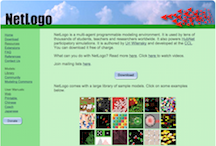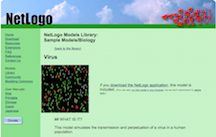 NetLogo Activity Outline
NetLogo Activity Outline
NetLogo is a multi-agent programmable modeling environment. It is used by tens of thousands of students, teachers and researchers worldwide. It is authored by Uri Wilensky and developed at the Center for Connected Learning. You can download it free of charge. You can learn more about NetLogo here.
Launch NetLogo (virus model)
For additional classroom activities, resources, and tips involving NetLogo modeling, visit the QUBES group "Community Group: Using NetLogo in the Classroom."
Goals for this activity:
- introduce agent based modeling
- explore a netlogo model in a way that lets you get a sense of how it can be used in class
- peek into some more advanced features and teaching opportunities
Initial exploration of the virus model:
There is information about this model available here (this file will be handed out).
Basics for using a model in NetLogo:
- Launch from link - Virus Model
- You use the "set-up" and "run" buttons to control the model.
- Some variables can be changed using sliders.
Working with a partner make some predictions about how you think the various parameters will influence the behavior of the model. Then explore the existing "parameter space" and observe the properties of the system. Collect a few specific observations to share with the large group during discussion
Whole group discussion:
- Groups will share what they learned,and questions they have about the biology or model.
- A few specific things to notice -
- Behavior of an Individual Based Model in contrast to a traditional equation based model.
- Here is a contrasting SIR model.
- Students are more comfortable thinking about behaviors of individuals than characteristics of population level phenomena.
- The three tabs and other NetLogo interface issues.
- What are the range of learning objectives (both content and process outcomes) that could be addressed using a NetLogo modeling experience?
Round two of modeling group work
Work with a partner and use one of the following suggestions to dig a little deeper into NetLogo.
Option 1: Get "under the hood" and explore ways to change the model that are not built into the sliders
- Use the variable called "carrying-capacity" to study the impact of population density on the spread of a virus.
- Introduce a single infectious individual to the population and see how the dynamics change in different situations.
- Modify the existing model to represent a different disease or a different host population.
- Use the "behavior space" option to explore a range of parameter values in a model in a collection of trials.
Option 2: Explore a different model
- epiDEM Basic
- epiDEM Travel and Control
- AIDS
- Tumor
- Wolf Sheep Predation
For a collection of microbiology research references using agent-based models, click here.

